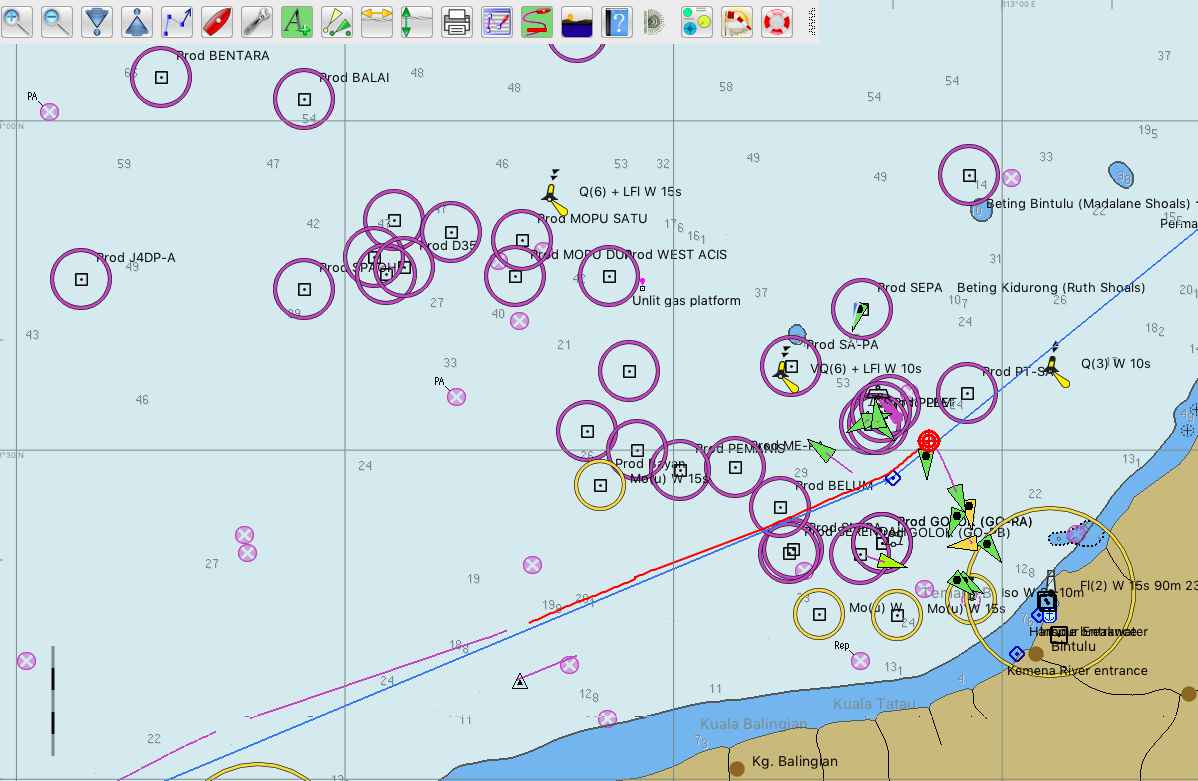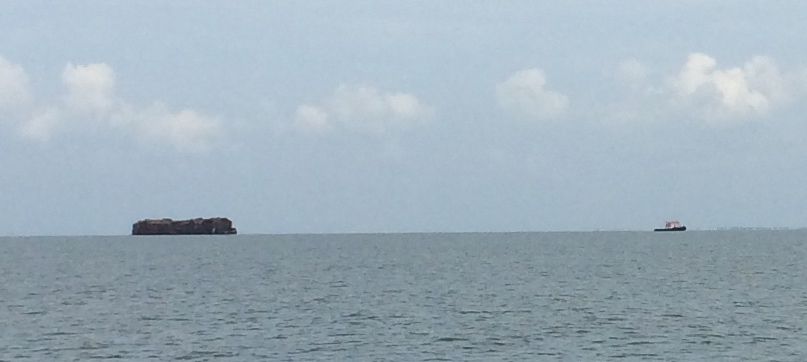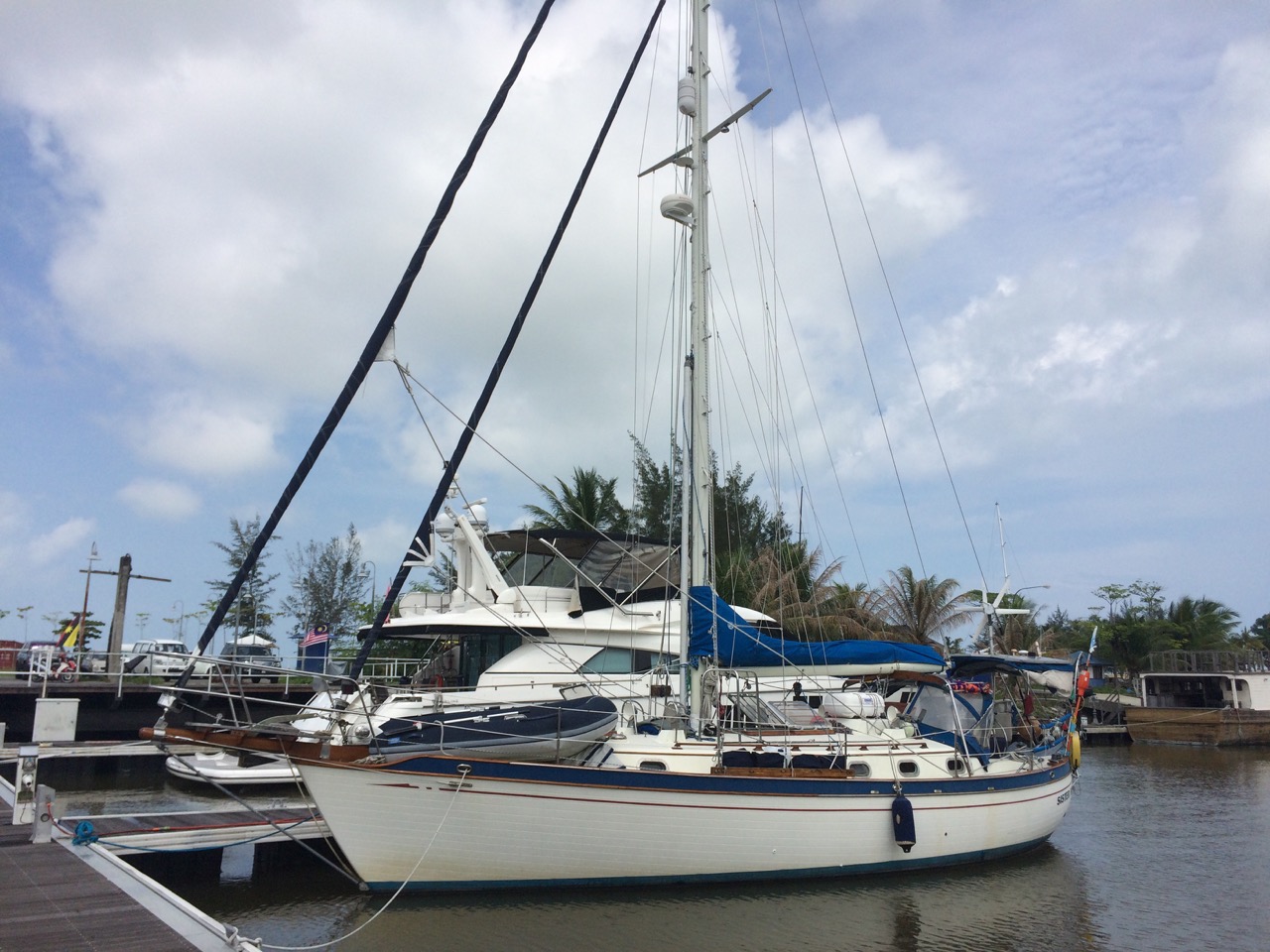We left Pulau Patok, into a heavy tide and swell which slowed us down to a couple of knots. The forecast was hopeless, possibly a little wind but from the wrong direction, also there wasn’t anywhere obvious to take shelter from the swell on the next 220 miles of coast, other than a commercial harbour, which looked a bit grim. so I decided, perhaps rashly, to go direct to Miri, which is 180 NM as the crow flies, and would take about 36 hours if we could average 5 knots. As it turned out we didn’t, and took 44 hours. Just before we arrived, we got a weather forecast over the NavText that the severe thunderstorms to the north of us would continue until yesterday. I have no idea what the point of such a forecast is, in fact I shouldn’t call it a forecast at all, perhaps a hindsightcast would be more appropriate. However that did explain why we had light winds, but huge swells.
We sailed offshore, which gave us a more direct route, but also kept us away from the inshore fishermen in their small unlit boats. We would have two nights at sea, and it was only when I got the correct charts up on my plotter that I realised just how many oil and gas platforms there are here.  I was fortunate that we would reach the first major block of them just as dawn arrived, it was the second night that was going to be a problem. We were low on fuel, so I took every opportunity to sail, even in such light winds. In fact I was really pleased at how well the boat sailed in just 5-10 knots of wind, I used the time to play with the sails and the rig to get the best performance. Slowly it’s all coming together.
I was fortunate that we would reach the first major block of them just as dawn arrived, it was the second night that was going to be a problem. We were low on fuel, so I took every opportunity to sail, even in such light winds. In fact I was really pleased at how well the boat sailed in just 5-10 knots of wind, I used the time to play with the sails and the rig to get the best performance. Slowly it’s all coming together.
There were lots of ships around, and a lot of them not lit correctly. The ones I hate the most are the tugs, sometimes they just have a small flashing light on the tow and the tug itself has a single white light.
Sometimes the tugs have AIS and so you know it’s a tug, other times you can just make out some lights and a shape on the radar. If you get in between the tow, you’re in big trouble, I hate to think what a mess it would make of our boat. The other thing is the tow, in this case above, a huge load of logs, is usually trying to go in a different direction to the tug, and the tug might be pointing in quite a different direction to what it is travelling, very confusing. At one point a fishing boat appeared behind me, this was my fault for not looking astern enough, but he would have been within 50ft, I shone a torch at him, and he turned on all his deck lights, killed the engine, then drifted, before quickly going around my stern and away. I’m not sure who was shocked the most!
I had a lot of notes about this area, and I re-read them again, and also found the admiralty guide had a section on this area, which cautioned against travelling here at night, unless you had a good clear full moon. I was expecting the moon to rise about 3AM, half moon, and hidden behind clouds. The main problem is well heads, underwater structures where oil is or had been extracted. There are a lot of disused well heads which apparently can come close to the surface and are not lit. A catamaran on the Sail Malaysia Rally hit one last year, fortunately no serious damage occurred. After a while I decided that most of the well heads would be within the designated fields, and I should be fine away from them. I was also worried that back home I got chased away from the Douglas Gas platform in the Irish sea as you are not allowed within 3nm of the rig, yet here the rigs were often only 4-5 nm apart, making that difficult. I later found out that 500m is the distance you have to keep away. As it turned out it all went quite smoothly, I dropped the mainsail about 6AM knowing sadly I wont be using that again for a few months. A squall came through just before dawn, and as the skies lightened, we approached Miri, where we planned to anchor at 7AM and contact the Marina for guidance in, and to wait for high water at 08:30. however the swell was so bad I decided I would prefer to motor round for an hour rather than anchor and be kicked around by the waves. Kathy and I had been doing 4 hour on /off watches, but not doing it properly and we were both tired now. Looking at the tide tables, I realised that as we only have one tide a day, the twelfths rule doesn’t apply, this rule is a way of working out how fast the tide comes in, and the upshot was we would have enough water to get in now, also big ships were ploughing into and out of the marina. So after a gap in the big ships, we shot in and grabbed a berth. It felt odd, I tried the bow thruster before we came in, but it was running for a second, then making a weird noise, I had worried that the fouling from Santubong may have affected it, but on closer inspection, i.e. me hanging over the bow while Kathy powered it up, made me realise that the swell was lifting the bow thruster clear of the water, and it was whizzing around in the air, not good for it. Once in the marina we moored up, it went remarkably well, Kathy jumped ashore with a line, I stopped the boat and passed her the other lines and that was the end of a ten week trip from our last Marina in Johor Baru.
Now we have to get used to having an electric kettle, a toaster that doesn’t burn the toast, and all the water we want from the tap.

That’s us above in Miri, now we have ten days to do a lot of cleaning up and putting away before we come home. but for now we are off to explore the area a little before a long deep sleep.
Paul Collister
